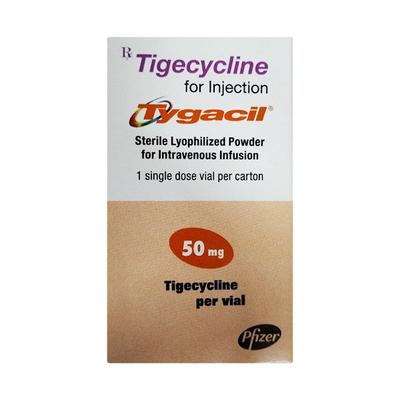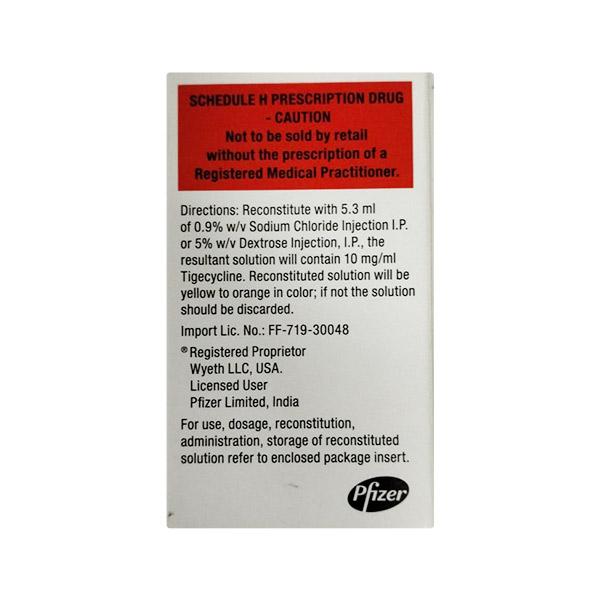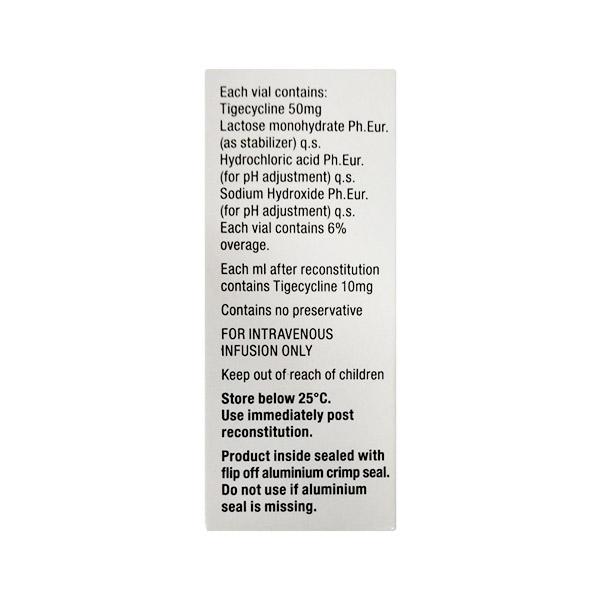

Netmeds First Membership
Quick Links
Introduction About TYGACIL INJECTION
TYGACIL INJECTION contains a medicine Tigecycline which belongs to a group of medicines called Antibiotics. It is used to manage serious infections such as complicated infection of the skin and soft tissues (the tissue below the skin), excluding diabetic foot infections.
TYGACIL INJECTION is also used to manage complicated infection in the abdomen. It is used when your doctor thinks that other antibiotics will not suit you.
Before receiving TYGACIL INJECTION, inform your doctor if you have liver diseases, slow or poor wound healing, diarrhoea, blockage of the bile ducts, allergy to tetracycline antibiotics or bleeding disorders.
TYGACIL INJECTION should be used with caution in pregnant and breast-feeding women. TYGACIL INJECTION is not recommended for use in children below 8 years of age. TYGACIL INJECTION can be used in elderly patients, however, consult with your doctor before receiving.
The most common side effects of receiving TYGACIL INJECTION are nausea, vomiting, diarrhoea, headache, injection site pain or inflammation or dizziness. Contact your doctor if the symptoms worsen or doesn’t improve.
Uses Of TYGACIL INJECTION
Manage serious infections such as:
- complicated infection of the skin and soft tissues (the tissue below the skin), excluding diabetic foot infections
- complicated infection in the abdomen
How TYGACIL INJECTION Works
TYGACIL INJECTION acts on the bacteria and disrupt the important life functions of the bacteria. It interferes with the present bacteria and disrupts the cell membrane along with hampering its various cellular function which leads to bacterial death.
How to use TYGACIL INJECTION
TYGACIL INJECTION will be given to you only by a doctor or a nurse into a vein as an intravenous infusion or injection. Your doctor will decide the correct dose and duration of TYGACIL INJECTION for you depending upon your age, body weight and disease condition.
Side Effects Of TYGACIL INJECTION
Common
- nausea, vomiting
- diarrhoea
- abscess (collection of pus), infections
- laboratory measurement of decreased ability to form blood clots (low platelets)
- dizziness
- injection site pain, inflammation, swelling and clotting
- abdominal pain, dyspepsia (stomachache and indigestion), anorexia (loss of appetite)
- increases in liver enzymes
- hyperbilirubinaemia (excess of bile pigments in the blood)
- pruritus (itching), rash
- poor or slow wound healing
- headache
- increase in amylase (may cause inflammation of pancreas characterised by pain in abdomen and back)
- increased blood urea nitrogen (frequent urination, fatigue, itching, swelling in ankles and feet)
- pneumonia
- low blood sugar
- sepsis (severe infections in the body and blood stream)/septic shock (serious medical conditions which can lead to multiple organ failure and death as a result of sepsis)
- low protein levels in the blood
Uncommon
- jaundice (yellow coloration of the skin)
- inflammation of the liver
Rare
- low fibrinogen levels in the blood (a protein involved in blood clotting)
Stop receiving TYGACIL INJECTION and contact your doctor immediately if you experience any of the following side effects:
- pseudomembranous colitis
- serious bowel inflammation symptoms such as bloody diarrhoea, abdominal pain or fever
- severe abdominal pain, nausea and vomiting (pancreatitis)
How To Manage Side Effects
Diarrhoea:
Drink lots of fluids, such as water or fruit juice to keep yourself hydrated. Do not consume any medicine on your own without consulting your doctor. Ask for your doctor’s advice if diarrhoea doesn’t improve.
Nausea:
Stick to simple meals while receiving TYGACIL INJECTION. Avoid eating rich or spicy food. Do not take any medication on your own. Ask for your doctor’s advice if nausea doesn’t improve.
Headache:
Try to take rest and don’t involve yourself in exertive activities. Rest in a quiet and dark room. Apply a pain-relieving balm on your forehead. Ask for your doctor’s advice if headache doesn’t improve.
Vomiting:
Drink clear or ice-cold drinks. Eat light, bland foods and avoid fried, oily or sweet foods. Avoid carbonated drinks. Ask for your doctor’s advice if vomiting doesn’t improve.
Dizziness:
Lie or sit down immediately when you feel dizzy. If you're feeling severe episode of spinning(vertigo), lie in a dark and quite place with eyes closed. Try to avoid vehicle driving. Discuss with your doctor if the symptom worsens.
Stomach pain:
Try to rest and relax. Try to have smaller and frequent meals. Keep a heat pad on your stomach. Take your physicians advice.
Loss of appetite:
Eat when you are hungry. Eat a nutritious snack rich in calories and protein, such as dried fruit and nuts. If the symptom does not show improvement, consult your doctor.
Low blood sugar:
Eat glucose tablets or another high sugar snack, like sweets, biscuits or fruit juice (always carry glucose tablets or a high sugar snack). Take enough rest. Consult your doctor if symptoms don’t improve.
Warning & Precautions
Pregnancy
TYGACIL INJECTION should be used with caution in pregnant women as it may cause foetal harm. If you are pregnant, think you may be pregnant or are planning to have a baby, ask your doctor for advice before receiving TYGACIL INJECTION.
Breastfeeding
TYGACIL INJECTION should be used with caution in breast feeding women as it is not known if it passes through breast milk. Consult with your doctor before receiving it.
Driving and Using Machines
Do not drive or use machinery if you feel dizzy after receiving TYGACIL INJECTION.
Liver
TYGACIL INJECTION should be used with caution in patients suffering from liver disease. Consult your doctor before receiving it.
Allergy
Do not receive TYGACIL INJECTION if you are allergic to Tigecycline or tetracycline class antibiotics such as minocycline, doxycycline or any other ingredients of this medicine.
Others
Before receiving TYGACIL INJECTION, inform your doctor if you have:
- slow or poor wound healing
- diarrhoea
- blockage of the bile ducts
- allergy to tetracycline antibiotics (skin sensitization to sun light, staining on developing teeth, inflammation of pancreas, decreased ability to form blood clot)
- bleeding disorders
Use in pediatrics:
TYGACIL INJECTION is not recommended for use in children less than 8 years of age due to the lack of data on safety and efficacy in this age group. Also, it may cause permanent dental defects such as staining on the developing teeth. Consult with your child’s doctor.
Use in geriatrics:
TYGACIL INJECTION can be used in elderly patients. However, consult your doctor before receiving it.
Interactions
A. Drug - Drug interactions:
Before receiving TYGACIL INJECTION, inform your doctor if you are taking any of the following medicine:
- anticoagulants such as warfarin (used to manage blood clotting)
- contraceptive pill such as desogestrel, ethinyl estradiol (used to manage pregnancy)
- tacrolimus or cyclosporine (used to suppress the immune system e.g., in organ transplants)
Overdosage:
TYGACIL INJECTION will be administered to you only by a doctor or a nurse in a hospital and so it is unlikely to receive an overdose. However, consult your doctor or nurse if you experience any unusual symptoms.
Synopsis
| Drug | : | Tigecycline |
| Pharmacological Category | : | Glycylcycline |
| Therapeutic Indication | : | Complicated infection of the skin, soft tissues and abdomen |
| Dosage Forms | : | Injection |
More Information
- Keep TYGACIL INJECTION out of reach of children
- Store TYGACIL INJECTION below 25°C
FAQs About TYGACIL INJECTION
Can TYGACIL INJECTION be used in children?
TYGACIL INJECTION is not recommended for use in children less than 8 years of age due to the lack of data on safety and efficacy in this age group. Also, it may cause permanent dental defects such as staining on the developing teeth. Consult with your child’s doctor.
Can TYGACIL INJECTION cause diarrhoea?
Yes, TYGACIL INJECTION may cause diarrhoea in some individuals. Drink lots of fluids, such as water or fruit juices to keep yourself hydrated. Avoid taking any medicine on your own for managing diarrheoa. Consult your doctor if the symptom did not improve.
How much time does it take to administer TYGACIL INJECTION?
TYGACIL INJECTION will be given to you only by a doctor or a nurse into a vein as an intravenous infusion or injection over a period of 30 to 60 minutes. Your doctor will decide the correct dose and duration of TYGACIL INJECTION for you depending upon your age, body weight and disease condition.
Can I take TYGACIL INJECTION during liver disease?
TYGACIL INJECTION should be used with caution in patients suffering from liver disease such as cholestasis (blockage of the bile ducts). Consult your doctor before receiving this medicine.
Does TYGACIL INJECTION affects my ability to drive?
Do not drive or operate any machines if you feel dizzy, after receiving TYGACIL INJECTION. You can continue doing your activities as soon as you feel normal again.
Do I need to undergo any tests while being managed with TYGACIL INJECTION?
Although antibiotics including TYGACIL INJECTION, fight certain bacteria, other bacteria and fungi may continue to grow. This is called overgrowth. Your doctor will monitor you closely for any potential infections and may prescribe a different antibiotic specific for the type of infection present.
References
1. KD. Tripathi. Tetracyclines and Chloramphenicol. Essentials of medical pharmacology. Seventh edition. 2013. Page –738.
2. Nickie D. Greer. Tigecycline (Tygacil): the first in the glycylcycline class of antibiotics. NIH National Library of Medicine, National center for biotechnology information. Pubmed Central. April 2006. [Accessed 25th November 2022]. https://www.ncbi.nlm.nih.gov/pmc/articles/PMC1426172/
3. Sajad Yaghoubi, Angelina Olegovna Zekiy, Marcela Krutova, Mehrdad Gholami, Ebrahim Kouhsari, Mohammad Sholeh, Zahra Ghafouri, Farajolah Maleki. Tigecycline antibacterial activity, clinical effectiveness, and mechanisms and epidemiology of resistance: narrative review. National center for biotechnology information. Pubmed Central. January 2021. [Accessed 25th November 2022]. https://www.ncbi.nlm.nih.gov/pmc/articles/PMC7785128/
4. Pharmadox Healthcare, Ltd. Electronic Medicines Compendium (EMC). [Revised in March 2022] [Accessed 25th November 2022]. https://www.medicines.org.uk/emc/files/pil.9232.pdf
5. Cipla Ltd. Tiganex Injection (Tigecycline). Ciplamed. [Revised in April 20222]. [Accessed 25th November 2022]. \https://www.ciplamed.com/content/tiganex-injection
Useful Diagnostic Tests
- Complete Blood Count










